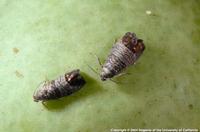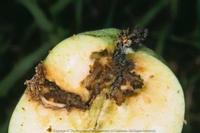Codling moth management
May is a good time to start controlling codling moths in your apple, pear, Asian pear, English walnut, and quince trees.
For detailed information about managing codling moths from UC IPM Online, click here to see the codling moth Pest Note. Read what Master Gardeners at the Fair Oaks Horticulture Center orchard have learned about codling moth management.
This year pheromone traps put out in March in the Sacramento area began catching numerous codling moths in late March in the Delta area and about a week later in Fair Oaks. Once the moths are actively flying, they start to mate and lay eggs. The eggs start hatching two to three weeks later and the emerging worms (larvae) crawl to the fruit and tunnel into them.
Management
There are many cultural and sanitation tasks that will help you to control the codling moths. The following are a few of the most important:
- Thin your fruit when they are marble size so they will not touch other fruit when mature.
- Check fruit weekly starting in mid-May, pick any fruit with worm holes, and destroy any worms inside.
- Pick up fallen fruit, check for worm holes, and destroy any worms inside.
If you choose to spray
The time to spray is at egg hatch when the spray will reach the worms before they are hidden inside the fruit. If you want to learn how to use computerized tools to time your spraying, read the degree-day calculator explanation here. The estimated timing for the Sacramento area this year is as follows:
- Locations near the Sacramento Delta should have made the first spray between April 22 and 25 (biofix was April 1, 2013 based on trap activity in the orchards)
- Locations near Fair Oaks should have made the first spray between April 28 and May 1 (biofix was April 11)
Warmer areas will have earlier codling moth activity than cooler areas.
If you have your own traps and caught large numbers of moths (over 10 to 20 moths per week), make the first spray seven days prior to the above recommendations in addition to the above dates.
One or two additional sprays may be needed for each generation, depending on the product you are using. Read your product label for the recommendation. If you are using the codling moth virus Cyd-X, the rate of application for homeowners is 1 teaspoon per 5 gallons water.
Check back on this website again in mid-late June for information on the second generation, and in August for the third generation. The timing depends upon how warm or cool the weather is.






